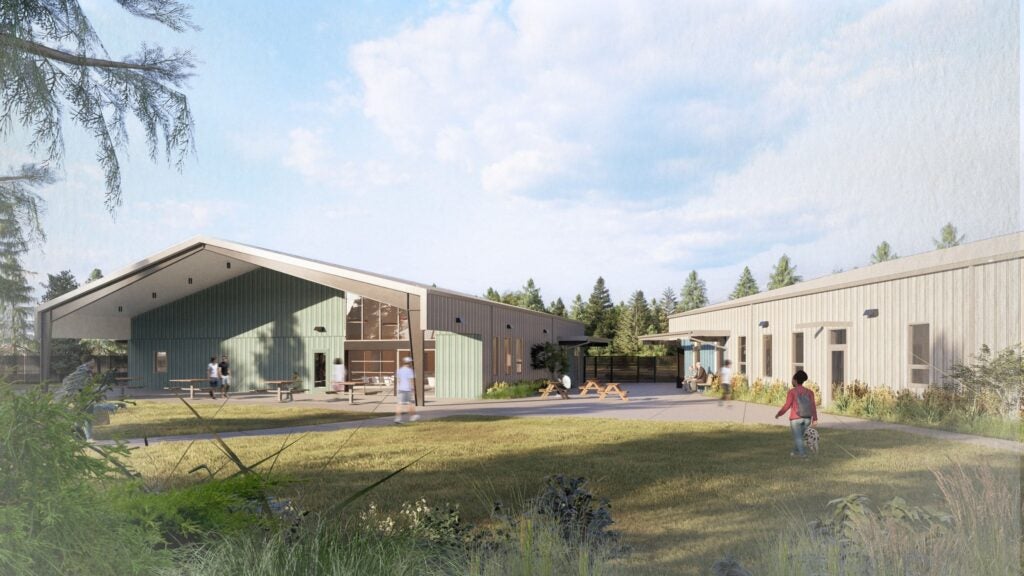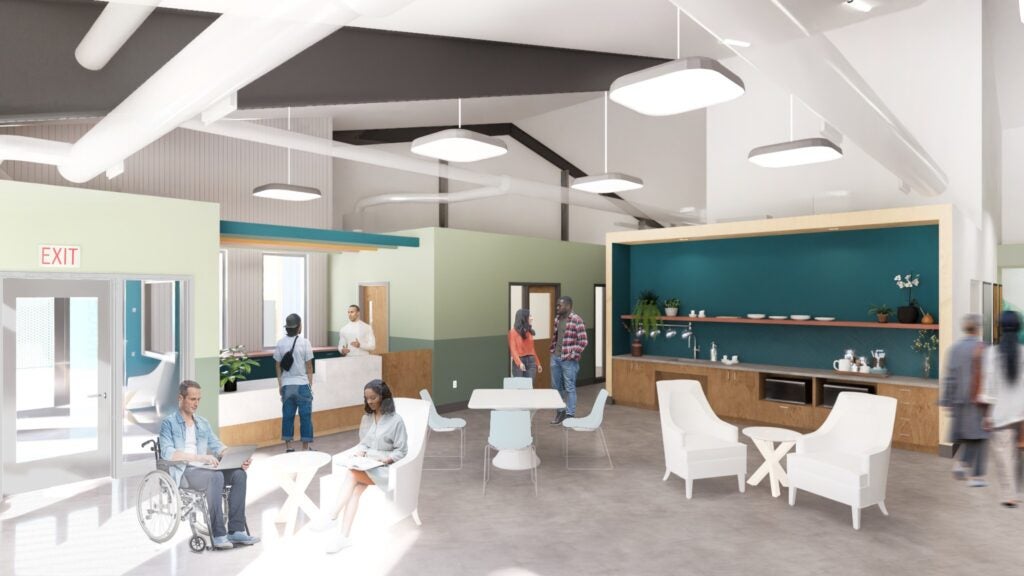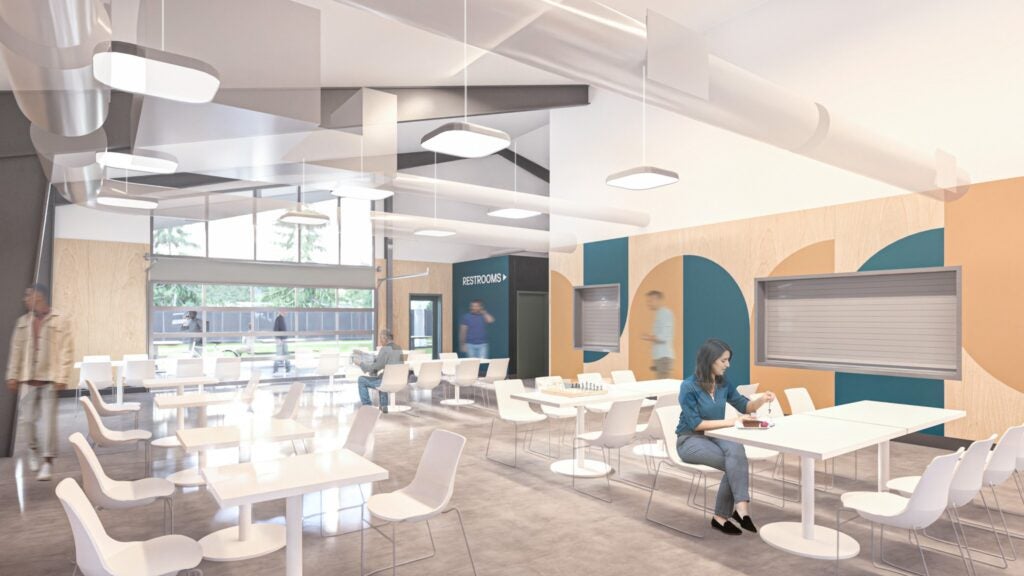Bridge Shelter
Coming fall 2026
A bridge shelter is a safe place for people experiencing homelessness to stay while they work toward permanent housing. It has fewer entry requirements than some shelters, making it easier for people to get the help they need.

Our Progress
In 2023, the City of Vancouver declared a homelessness emergency. A key component of the City’s emergency response action plan includes the opening of a bridge shelter with up to 120 beds. The shelter, located at 5313 N.E. 94th Ave., will provide medication-assisted treatment and other support services to help people transition to stable housing.
The City is working urgently to construct and open the shelter in 2026.
Key Milestones
What’s next
Construction is expected to begin in November.
Fall 2025
- Shelter construction contract awarded to Tapani, Inc. (Oct. 13)
Spring/Summer 2025
- Shelter design complete and pre-bid process for contractors opened (Sept.)
- Demolition of existing, vacant buildings on the property completed (June – July).
- Approved a purchase agreement with BlueScope for a steel building to house the bridge shelter (July 7).
- Building permit submitted (July 14).
- Additional funding secured from Clark County, PeaceHealth and the Community Foundation of SW Washington Ed & Dolly Lynch Fund.
- Initial shelter design completed.
Winter 2024
- Shelter architect hired – Scott Edwards Architecture for design and engineering.
- Shelter location approved – Vancouver City Council approved both the purchase and use of property located at 5313 N.E. 94th Ave.
- Emergency shelters opened (Dec. 2024 – March 2025) – the City opened select City-owned properties as temporary winter shelters to help meet urgent demand for shelter bed space.
Fall 2024
- Shelter operator hired – Do Good Multnomah will operate the site and is now working with the City on shelter design and an operations plan.
Stay Informed
In November 2024, the City held two community information sessions to explain the bridge shelter plan, answer questions and gather ideas. Watch the Nov. 19 info session recording.
Subscribe to project updates to learn about upcoming opportunities to ask questions and share your ideas.
Frequently Asked Questions
Why do we need a bridge shelter?
While Vancouver’s homelessness response strategies are working, the complexity and magnitude of homelessness in Vancouver continue to grow. When the pandemic hit, homelessness spiked. The number of homeless people in Clark County grew by about a third between 2020 and 2022.
- Since Dec. 2021, the City has more than doubled the number of shelter beds available to adults experiencing homelessness in Clark County – adding up to 160 new beds across the city through our four Safe Stay Communities.
- Since 2021, 502 people have lived in Safe Stay communities, including 86 current residents (as of July). 50% of those exiting Safe Stays move into stable housing.
Before the Safe Stay program, Clark County had fewer than 100 year-round beds for homeless adults, fewer than 15 beds for single women and no options for couples without children.
Despite this progress, there are not enough shelter beds to house the more than 500 Vancouver residents who remain unsheltered. The consequences of unsheltered homelessness can be deadly:
- The Vancouver Fire Department responded to 2,489 medical/EMS calls related to homelessness in 2024.
- At least 53 people experiencing homelessness died in 2024, representing a 70% increase from the previous year
- 50% of these deaths were due to overdose. These overdose deaths occur largely among people who are living in isolation, either unsheltered or in individual supportive housing.
While there have been overdoses and deaths in shelters, no deaths due to overdose have been reported. In addition to filling a much-needed gap in shelter capacity, the bridge shelter model, including on-site behavioral health services, can provide a lifesaving stepping stone for adults experiencing addiction before transitioning into housing.
What services will be available in the bridge shelter?
The bridge shelter will provide 24/7 on-site support by a non-profit operator. To help with the critical needs of those seeking help, the shelter will include on-site medication-assisted treatment and other substance use disorder services, including peer recovery support. The shelter will also be able to expand capacity for severe weather events.
Services
- Day-to-day support: Case management, housing assessments, peer-to-peer recovery support, meals and hygiene services.
- Medication-Assisted Treatment Program: Treatment for substance use and mental/behavioral health support provided by the Cowlitz Indian Tribe.
- Other services: Work opportunities, education, animal care/clinics and space for severe weather shelter.
Who will administer Medication Assisted Treatment at the Bridge Shelter?
The Cowlitz Indian Tribe will provide medical services to treat drug addiction at the Bridge Shelter. As Seekers of the Medicine Spirit, the Tribe is committed to serving, healing, and uplifting Tribal members and the broader community. Through its network of clinics and treatment programs, the Tribe delivers opioid treatment services, counseling, and behavioral health care to ensure that individuals have access to the care and support they need.
How much will the bridge shelter cost?
Estimated costs
- ~$22 million: To acquire the property and construct the shelter. Construction costs are approximate based on ongoing market changes.
- $6.5 million: Annual operating and management cost in the first year. This cost would grow at the rate of inflation annually for the shelter’s 10-year lifespan.
How is the bridge shelter being funded?
Funds to establish the shelter will come from the existing City budget. The City’s 2025-26 budget established a new Business and Occupation tax that will provide most of the funding needed for operating the shelter.
Staff also continue to seek additional funding sources, including federal/state grants, private philanthropic donations and local partnerships.
Funding partners to date
- $2.75 million from Clark County Opioid Abatement Council.
- $2.1 million from Clark County’s Mental Health Sales Tax (a fund reserved for chemical dependency or mental health treatment services, or therapeutic courts).
- $800,000 PeaceHealth Community Health Improvement Plan Grant to help build a commercial-grade kitchen.
- $1.9 million grant from the Ed and Dolly Lynch Fund, Community Foundation of Southwest Washington for up to eight new, limited-term positions on our Homeless Assistance and Resources Team (HART) to provide outreach and help guide people into the shelter once it opens.
Where is the bridge shelter located?
After researching several potential properties, the City selected the property located at 5313 N.E. 94th Ave. in the Van Mall neighborhood. This three-acre property is a good fit for the shelter because it’s:
- located near a transit line,
- zoned for General Commercial, which allows this use,
- large enough to accommodate the shelter.

Why wasn’t the existing building on the property used for the shelter?
The cost of retrofitting the vacant building for a shelter would have been significantly higher than constructing new buildings. To shorten the construction schedule and reduce construction costs for the project, the City is using a steel building (Pre-Engineered Metal Building) manufactured by BlueScope for the shelter’s building shells.
All buildings on the property were demolished, including the former Naydenov Gymnastics facility and two vacant homes.
Why did the City select a pre-engineered metal building for the shelter?
The City is using a mostly steel, pre-fabricated structure, called a pre-engineered metal building, to house the future shelter.
This type of building is beneficial in several ways:
- Shorter construction time: The building is fabricated off-site, concurrent with site preparation, and can be built very quickly.
- Durability: Made to last, resistant to extreme weather conditions and fires.
- Saves cost: Precise engineering and an efficient fabrication environment saves on materials, labor and energy.
- Sustainability: Made with highly recyclable materials and energy-efficiency designs.
How long will the bridge shelter operate?
What kind of code of conduct will exist for those who enter the bridge shelter?
To access shelter services, individuals must follow a code of conduct/rules. The code of conduct will be developed by the service provider (Do Good Multnomah), with input from people with lived experience with homelessness and informed by the best practices used for the City’s Safe Stay/Safe Park communities, and the needs/concerns of surrounding neighbors and businesses.
Yes. There are many tools to address the complex needs of unsheltered people in Vancouver (Safe Stay Communities, Safe Park, etc.), but no single solution or shelter style will work for everyone. The bridge shelter will allow us to get many unsheltered adults indoors and safely supported, for the lowest possible cost.
Following the negotiation and acquisition of property for a potential shelter, we mailed an initial postcard notice to all neighbors and businesses within 1,200 feet of the property. Additional community engagement, including an in-person and virtual event, took place in Nov. 2024.
A robust community engagement process, including online and in-person outreach, will help us address community concerns and incorporate feedback into final plans and operating procedures for the bridge shelter.
Sign up to receive email updates about the project and future community engagement opportunities.




